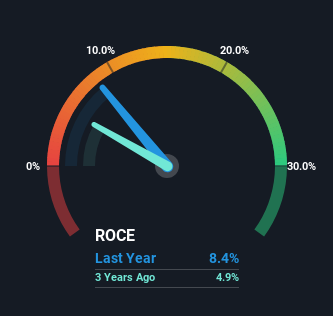Harley-Davidson (NYSE:HOG) Hasn't Managed To Accelerate Its Returns
If we want to find a potential multi-bagger, often there are underlying trends that can provide clues. One common approach is to try and find a company with returns on capital employed (ROCE) that are increasing, in conjunction with a growing amount of capital employed. Ultimately, this demonstrates that it's a business that is reinvesting profits at increasing rates of return. In light of that, when we looked at Harley-Davidson (NYSE:HOG) and its ROCE trend, we weren't exactly thrilled.
What Is Return On Capital Employed (ROCE)?
Just to clarify if you're unsure, ROCE is a metric for evaluating how much pre-tax income (in percentage terms) a company earns on the capital invested in its business. The formula for this calculation on Harley-Davidson is:
Return on Capital Employed = Earnings Before Interest and Tax (EBIT) ÷ (Total Assets - Current Liabilities)
0.084 = US$745m ÷ (US$12b - US$3.5b) (Based on the trailing twelve months to March 2024).
So, Harley-Davidson has an ROCE of 8.4%. In absolute terms, that's a low return but it's around the Auto industry average of 9.3%.
See our latest analysis for Harley-Davidson
In the above chart we have measured Harley-Davidson's prior ROCE against its prior performance, but the future is arguably more important. If you'd like to see what analysts are forecasting going forward, you should check out our free analyst report for Harley-Davidson .
So How Is Harley-Davidson's ROCE Trending?
There are better returns on capital out there than what we're seeing at Harley-Davidson. Over the past five years, ROCE has remained relatively flat at around 8.4% and the business has deployed 27% more capital into its operations. Given the company has increased the amount of capital employed, it appears the investments that have been made simply don't provide a high return on capital.
The Bottom Line On Harley-Davidson's ROCE
In conclusion, Harley-Davidson has been investing more capital into the business, but returns on that capital haven't increased. And with the stock having returned a mere 9.1% in the last five years to shareholders, you could argue that they're aware of these lackluster trends. As a result, if you're hunting for a multi-bagger, we think you'd have more luck elsewhere.
One final note, you should learn about the 2 warning signs we've spotted with Harley-Davidson (including 1 which is a bit concerning) .
If you want to search for solid companies with great earnings, check out this free list of companies with good balance sheets and impressive returns on equity.
Have feedback on this article? Concerned about the content? Get in touch with us directly. Alternatively, email editorial-team (at) simplywallst.com.
This article by Simply Wall St is general in nature. We provide commentary based on historical data and analyst forecasts only using an unbiased methodology and our articles are not intended to be financial advice. It does not constitute a recommendation to buy or sell any stock, and does not take account of your objectives, or your financial situation. We aim to bring you long-term focused analysis driven by fundamental data. Note that our analysis may not factor in the latest price-sensitive company announcements or qualitative material. Simply Wall St has no position in any stocks mentioned.

 Yahoo Finance
Yahoo Finance 
